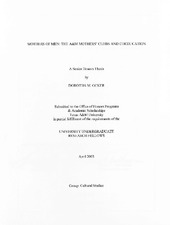| dc.description.abstract | In 1933 the Texas A&M Mothers' Clubs sent petitions and letters to the Board of Advisors requesting that Texas A&M University retain its all-male status. While most studies of women opposed to equal rights center on the women maintaining power through their feminine sphere of influence, the mothers of the A&M Mothers' Clubs at this time were more concerned with being defined as good mothers by maintaining their sons' power. My research of the action of the A&M Mothers' Clubs focuses on two main aspects: a historical perspective and the social construction of motherhood. In 1933, the United States faced the worst of the Great Depression, with no end in sight. Every spot a woman had in either education or the workforce was considered one less spot for a man. Gender, or the social construct defining roles for men and women, at the time dictated that men become wage earners and support a family. It was very important in a time of high unemployment that men find a way to fulfill their roles. Men spent most of their time outside of the home, and mothers stayed home with their children. Society feared that males raised by mothers would become too feminine, so mothers were advised to teach their sons masculinity, or their proper gender role. The social construction of motherhood also greatly changed during the 1910s when these women were raising their sons. Society began to treat motherhood as a profession, and like all professions of the times, there was a right way and a wrong way to perform your job. Known as scientific motherhood, mothers during this time were advised exactly how to raise a child. Direct participation in a child's education was also common, with Parent Teachers' Associations springing up across the country. Psychologically, mothers began to bear the brunt of disorders. More and more problems were attributed to the effects of bad mothering upon a child, and mothers strove to earn the label of good mother. The Victorian era glorification of the mother was slowly disappearing when these women entered motherhood. When these forces combined to work on mothers from the 1910s to 1930s, women cared about the status of their sons. In an effort to maintain their sons' gender role of provider, secure him a spot in education, and be an involved mother, the mothers of the Texas A&M Mothers' Clubs worked to maintain the all-male status of Texas A&M University. Like other women opposed to equal rights, these women organized themselves into an effective group, but unlike those women, the mothers of the A&M Mothers' Clubs strove to maintain their sons' power, and not their own. | en |


